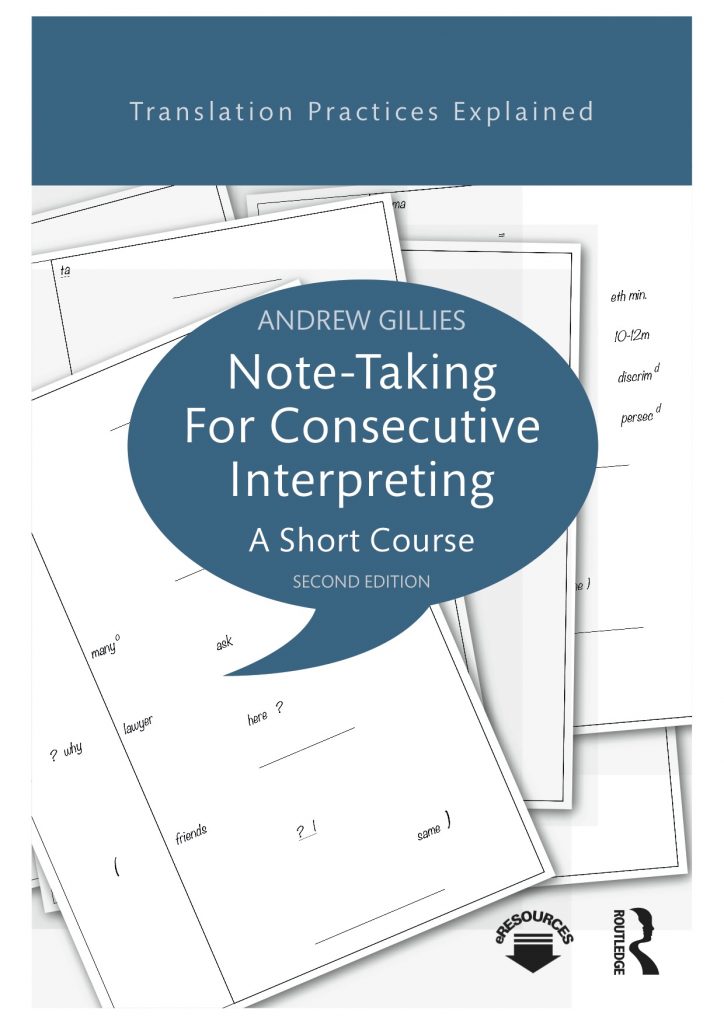The following review of Andrew Gillies’ book, Note-taking for Consecutive Interpreting, was written for this site by Martin Wooding. Martin is a staff interpeter at the European Parliament with 20 years experience in the job and is editor of the EP’s interpreter bulletin, LINGUA FRANCA. He has also been involved in interpreter training for, and at, the EP for many years, most recently with young Bulgarian interpreters.
Reviewed by Martin Wooding
Having gone through the dismal experience of evaluating many a student insufficiently trained in the art of proper consecutive note-taking, I would be relieved if Andrew Gillies’ handy guide to the subject were made compulsory reading in the class-room. Clearly organised, attractively presented and written (refreshingly) in English, it provides welcome support for professional standards.
Whilst it is true (and the author readily concedes this point) that every interpreter has his own manner of noting a speech, it is also true that some manners are superior to others. The natural tendency of the uninitiated is to note keywords as one would compose an ordinary text, line after line. Maybe in places where the paper supply is a major constraint this method has some primitive virtue to it, and if your memory is sound you may additionally manage to preserve the details of the original in the right order. However, I have yet to see an interpreter reproduce a speech on this basis, rather than regurgitate lifeless words.
The key to a good consecutive rendering is structure. No interpreted speech stands up without the backbone of a structure. In fact, as Mr Gillies intimates, an interpreter is almost forced by his profession to structure his output more rigorously than the original speaker. The speaker chooses words intuitively, and as long as he sticks to his own experience his discourse is going to carry some conviction, with or without a formal structure. The interpreter is not choosing words to fit an experience of his own, but doing his best to imitate someone else’s. Here is all the difference between nature and art. The firm structure of the artefact has to make up for what nature cannot supply.
Structure is the reason why the well-advised interpreter notes his link-words in the left-hand margin and writes diagonally across the page. Structure is why he separates each idea with a horizontal stroke. Structure is why he makes a vertical stack of conceptually similar items (parallel values in Mr Gillies’ terminology). The good consecutive interpreter is an efficient sorter. As each part of the jigsaw is handed to him he diligently places it in its category: the edge bits here, the other bits there according to colour. He knows that’s the only way to rebuild the picture when his turn comes.
After progressing through the classical approach to structure in his section on the ‘Basics’, Mr Gillies adds a ‘Fine-tuning’ section with a wealth of valuable little tips from which I daresay even seasoned practitioners may learn a thing or two. Browsing this section is rather like visiting a professional cookery store and discovering there is actually some clever little implement which copes elegantly with a task you had previously deemed irksome. I certainly came away with a couple of new tools I look forward to using.
The stream of books about interpretation is sluggish at best. Professional interpreters don’t write about their job, and students don’t read. This would be fine if there were enough of the first category to impart their skills by personal example to the second. With the rapid development of the market for interpretation and the appearance of many new languages on the conference scene, this condition is very far from being fulfilled. Interpreting is taught by non-interpreters to students who have no exposure to the real thing. Moreover, the eastward infiltration of the ‘extended’ mode of consecutive interpretation has disoriented even professional teaching methods in Central Europe. Andrew Gillies’ book therefore spreads the Gospel at a time when aspiring interpreters sorely need to hear it.
